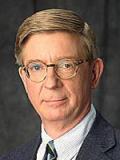
One hundred years ago, two events three days apart set the 20th century's trajectory. On April 9, 1917, in Zurich, Vladimir Lenin boarded a train. Germany expedited its passage en route to Saint Petersburg -- known as Leningrad from 1924 to 1991 -- expecting him to exacerbate Russia's convulsions, causing Russia's withdrawal from World War I, allowing Germany to shift forces to the Western Front.
Lenin boarded the train three days after the United States, responding to Germany's unrestricted submarine warfare and other provocations, declared war. Soon 2 million Americans would be in Europe. They, and the promise of many more, compelled Germany to accept an armistice at the eleventh hour of the eleventh day of the eleventh month of 1918.
Monday night and the next two nights, PBS' "American Experience" will present a six-hour documentary, "The Great War." Watch it and wince. It covers familiar diplomatic and military events, before and after America's bloodiest battle, the Meuse-Argonne offensive, in which American fatalities averaged 550 a day for 47 days.
Woodrow Wilson imposed and incited extraordinary repressions: "There are citizens of the United States ... born under other flags ... who have poured the poison of disloyalty into the very arteries of our national life. ... Such creatures of passion, disloyalty and anarchy must be crushed out. ... They are infinitely malignant, and the hand of our power should close over them."
His Committee on Public Information churned out domestic propaganda instructing the public how to detect pro-German sympathies. A 22-year-old Justice Department official named J. Edgar Hoover administered a program that photographed, fingerprinted and interrogated 500,000 suspects. Local newspapers published the names of people who were not buying war bonds or otherwise supporting the war. People were fired or ostracized for insufficient enthusiasm. The Espionage Act of 1917 made it a crime to "collect, record, publish or communicate" information useful to the enemy.
In Illinois, Robert Prager, a German-American coal miner suspected of spying, was stripped, marched through the streets and hanged. The Washington Post deplored such "excesses" but applauded the "healthful and wholesome awakening in the interior part of the country."
Josef Hofer and his two brothers were South Dakota Hutterites whose faith forbade any involvement in war, including wearing a military uniform. They were arrested in March 1918, and a week after the armistice they were sent to Fort Leavenworth, Kansas. Arriving at the military prison around midnight, they stood naked for hours in a 17-degree November night. Then they were suspended naked from the bars of their cells, their feet barely touching the ground, refusing to wear the uniforms left in their cells. Fed only bread and water, after two weeks David Hofer was allowed to telegraph to Josef's wife, telling her that her husband was dying. He died the morning after she arrived. Prison guards mocked his corpse by dressing it in a uniform.
The U.S. military was the world's 17th largest in April 1917, smaller (less than 250,000) than Romania's, and smaller than Britain's casualties in one battle. America's military became a melting pot for a nation in which one-third of the population had been born abroad or whose parents had been. Forty-three languages were spoken in one Army division raised in New York. One group was ineligible for melting: Printed at the bottom of draft registration cards were these words: "If person is of African descent, tear off this corner."
The African-Americans from around the nation who joined New York's 15th National Guard Regiment, the Harlem Hellfighters, included Leroy Johnston from Phillips County, Arkansas. He spent nine months in French hospitals recuperating from wounds suffered in the Meuse-Argonne, then in 1919 returned to an Arkansas seething with fears of an African-American insurrection because a returning African American veteran had formed a union of black sharecroppers. The narrator of "The Great War" says that as groups of white men "roamed the countryside, killing hundreds of black people, a train pulled into the station. A crowd rushed aboard and dragged out four unsuspecting black men. They were Leroy Johnston and his three brothers." After a melee, "the mob shot the Johnston brothers to pieces."
The war unleashed a flu pandemic that killed more people in a year -- somewhere between 20 million and 50 million -- than the war killed in four years. The flu's victims included Randolph Bourne.
George Will's email address is georgewill@washpost.com.
(c) 2017, Washington Post Writers Group


